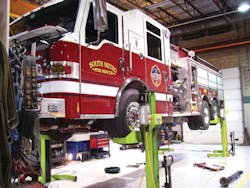Fire apparatus is getting more high-tech and complex every year. As more electronics and whiz-bang gizmos make their way into our lives, they are making their way onto fire trucks as well.
Computers, sensors, controllers and miles of wire serve as the central nervous systems of the 40,000-pound beasts that are today's fire apparatus. Virtually every piece of the apparatus — from controls for the engines, steering, suspension, pumps, radios and even simple things like warning lights — has some kind of electronics component helping it function.
This is the third story in a series of four for 2010 on the topic of apparatus maintenance by Firehouse® Magazine and Firehouse.com. For expanded coverage, including photos and audio podcasts go to http://www.firehouse.com/0810-apparatus.
According to information from the Fire Apparatus Manufacturers' Association (FAMA), an average of 5,650 apparatus are purchased each year, and they all have some form of electronic computer controls, whether they are commercial or custom cab apparatus. FAMA estimates there are 70,000 fire apparatus in service in the United States and that more than half are over 15 years old, from when electronics and high-tech equipment were not as prevalent as they are today. That still means there are a lot of apparatus in service today with more or less electronics on board, depending on the age of the vehicle, and more new apparatus being added to the national fleet daily.
The good news is that even though apparatus are complex these days, the on-board high-tech components are very reliable and require very little maintenance.
"One of the good things about apparatus today is they don't require much work," said Jason Witmier, pumper/tanker product manager for KME Fire Apparatus in Nesquehoning, PA. "And when they do, a lot of it is remote serviceable with a phone line or Internet connection so a guy at the factory can remotely diagnose a problem and in some cases, reprogram it to fix the problem."
Preventing System Failure
A recent incident in Seattle, WA, however, highlights that those high-tech systems can fail and need to be checked regularly and repaired immediately when a fault is detected.
On June 12, an apparently faulty electronic pad caused a Seattle apparatus to be unable to pump water at the scene of a fire where five people died. There is no indication the pumping failure led to the deaths.
According to KIROTV.com, a local TV station website, Seattle Fleets and Facilities workers spent 39 hours inspecting the apparatus before discovering the faulty electronic pad. The discovery led to Seattle's decision to replace the pads in 10 apparatus.
Incidents like Seattle's are rare, but obviously do happen, said Chief Brian Brown of the South Metro Fire Rescue Authority (SMFRA) Fleet Services Bureau in Centennial, CO.
"When something like that happens, you're done," said Brown. That's why he says he's a big advocate of checking everything on an apparatus on a daily basis.
"Exercise it every day," Brown said. "If you can't do it every day, because you're a small volunteer department, at least exercise it once a week. …There are things that should be done on apparatus daily, weekly and monthly."
Brown is an award-winning Emergency Vehicle Fire Apparatus Technician Level I and II, as well as an Automotive Service Excellence (ASE) Master Certified Automobile Technician and Master Medium/Heavy Duty Truck Technician. He is also an academy instructor for the Colorado Fire Mechanics Association and an Emergency Vehicle Technician (EVT) testing proctor and a participant of the EVT validation committee.
Brown said it is the apparatus engineer's responsibility to make sure the vehicle performs as required. If it doesn't, it must be reported and fixed immediately or at least decided whether the performance issue warrants it to be taken out of service.
Too often, Brown said, an intermittent problem shows up, so something doesn't work as it should and it's passed off as a glitch and ignored. That kind of a decision could come back to haunt someone when an apparatus doesn't pump water, or a piece of equipment doesn't work as required during an emergency.
Standards for Apparatus Maintenance
The National Fire Protection Association (NFPA) has a set of written standards pertaining to the maintenance of apparatus.
National Fire Protection Association (NFPA) 1911: Standard for the Inspection, Maintenance, Testing, and Retirement of In-Service Automotive Fire Apparatus, 2007 edition, is filled with instructions on how high-tech components should be maintained and tested.
Gary Handwerk, engineering manager for Hale Products, a pump manufacturer headquartered in Conshohocken, PA, has been a member of the NFPA Fire Apparatus Standards Committee for more than 18 years. As one of the authors of NPFA 1911 standards, he's a huge proponent of them.
"If you really follow 1911, there are tests for all of that stuff," said Handwerk, who's been connected with the manufacturing of apparatus and components for nearly 40 years. "Inspections and testing are very important."
Too often, however, the tests are not done because they can be complex and reveal problems the mechanic may not know how to fix, or that the community is unwilling to pay to have diagnosed.
"A lot of guys will…only do a tiny fraction of the testing because they want to change some (pump) valves, or do some repacking or change a gauge, but they don't want to get into the more difficult things," Handwerk said.
For example, Handwerk said, electronic pressure controls for pumps require no maintenance and are nearly problem-free. However, unreported problems can lead to dire consequences — like those in Seattle.
To avoid the kinds of pitfalls with testing that Handwerk mentioned, Stephen Wilde, the president of the EVT Certification Commission Inc., said it's important to find technicians who are well-qualified and versed in electronics and computer controls. With more than 35 years experience repairing emergency vehicles, Wilde is also committee chairman of the NFPA 1071, Standard for Emergency Vehicle Technician Professional Qualifications committee.
Those standards clearly state that people who work on fire apparatus and emergency equipment must know how to do electronic diagnostics and be able to effectively work on the high-tech equipment on apparatus. He recommends that anyone with responsibilities for maintaining apparatus, or ordering it done, become familiar with the terms of the document.
"A lot of people have never heard of it," Wilde said. "It spells out specifically what is required of a qualified technician."
And Handwerk said that's a good thing.
"Why would you let anyone who is not qualified touch your apparatus?" Handwerk asked. "It just doesn't make sense."
Qualified Maintenance
Wilde, who is also president of Certified Fleet Services Inc., a service center for fire apparatus and ambulance repairs in the metro Chicago area, said too many chiefs are willing to consign apparatus maintenance to firefighters who may not be qualified for the job.
"I don't go running into burning buildings and firefighters shouldn't be doing (intensive) vehicle inspections," Wilde said.
Wilde said he believes that the fire service is in a "transition period" in which a lot of basic apparatus are still on the road with more high-tech vehicles coming on line each day.
Old or new, apparatus still needs preventative maintenance, but that work is becoming more sophisticated these days, Wilde said.
"A PM (preventative maintenance) isn't just doing an oil change," Wilde said. "It's a lot more than that today."
Today, technicians need to know all about on-board diagnostic (OBD) computers and know how to interpret the communications between apparatus and the diagnostic tools. In his shop, Wilde said technicians have laptops and access to more than $8,000 of computer software just to do their jobs.
"Fire trucks are very complicated and, unlike personal vehicles, you don't trade them in every three years," Wilde said. "So, there has to be a lot of preventative maintenance and diagnostic work to keep them performing well."
A classic example how different fire apparatus is today, compared to yesteryear, is the throttle — the good old accelerator pedal. Years ago, it was mechanical with a cable that physically actuated the accelerator. Today, it's done by electronic Throttle Position Sensor (TPS) technology that interprets where the pedal is and accelerates the engine accordingly.
"There was a time you would step on the accelerator and the engine would speed up, almost no matter what," Wilde said. That's no longer the case as the engines, in both commercial and custom apparatus, have electronic controls that communicate with the transmission, the pump and the operator. All of those components, and more, operate with electricity and Wilde said that's why it's important that firefighters and technicians take apparatus through operational checks on a regular basis.
Because wiring and electrical signals almost always need grounds to complete the circuit, corroded wiring grounds (commonly found on apparatus) can wreak havoc with electrical systems and the controls connected to it. A well-qualified technician could find that problem in minutes, using computerized diagnostic equipment, whereas it may take six or eight hours to trace wiring the old-fashioned way, Wilde said.
Worse, having unqualified people messing around with high-tech electronic gear can actually cause more damage, Wilde said. He noted that a fire department with which he is familiar shorted out a $4,000 engine control module simply because they didn't understand how it worked. "That's an expensive lesson to learn," he said.
A fad that seemed to catch on a few short years ago, multiplex wiring of apparatus, seems to be waning, Wilde said. It seemed to be state of the art for a while, but he has noticed a trend going back to more old-school wiring, a move he welcomes. The standard automotive wiring is generally more reliable and is more user and mechanic friendly. Hacking into a multiplex wiring system on apparatus today, for a user-installed accessory, can do serious harm to the electrical system and, perhaps, even render it out of service.
"Multiplex was a way research and development could write out the competition that couldn't do it," Wilde said, noting that many departments are rejecting the high-tech multiplexing systems in bids currently.
"Today," he said, "everybody is doing multiplexing, so it's not a good tool for that any longer."
Is High-Tech Right for You?
For all their pluses and minuses, Wilde said, high-tech components have improved fire apparatus on a number of fronts, foremost for electric load management and efficiencies.
"Nine out of 10 times, or more, they work perfectly," Wilde said. "And when you're talking about thousands of jobs a month, that's a good average."
Brown, from the SMFRA Fleet Services Bureau, said the average fire truck these days has up to eight computers onboard, and that is not including the mobile data terminal (MDT) laptop in the cab for fireground operations. The best way for a firefighter to maintain those units is to exercise them and document their performance, he said.
"You can't pencil whip the inspection documents," Brown said. "Everything on the inspection has to work and you have to document that it does. If it doesn't, you need to report it to someone that it's not working."
There are some things that will most likely require dealer or manufacturer intervention to repair or troubleshoot, said KME's Witmier.
Event Data Recorders (or the proverbial "black box" for apparatus) and airbag and rollover protection devices are among examples of components that may need factory involvement to fix, Witmier said.
"There's nothing user-serviceable on any of those components," he said.
For Handwerk, there's a fundamental issue to all the high-tech components on apparatus these days.
"Are you sure you should have bought all that (stuff) in the first place?" Handwerk asked. "If you are going to buy all that high-tech stuff, the electronic whiz-bangy stuff, then you better be willing to pay the high-tech price to maintain it," Handwerk said. "…If you don't test it, per NFPA 1911, you're going to have some real problems."
ED BALLAM, a staff writer for Firehouse.com, is a firefighter with the Haverhill Corner, NH, Fire Department, a nationally certified EMT, and holds certifications in emergency vehicle operations and pump operations. He is a former managing editor of Fire Apparatus and Emergency Equipment magazine.

Ed Ballam
Ed Ballam served as associate editor for Firehouse. He is the assistant chief of the Haverhill Corner, N.H. Fire Department, and a National Registered EMT. He is also a Deputy Forest Fire Warden for the New Hampshire Division of Forests and Lands. Professionally, he's been a journalist for over 35 years working for a variety of publications, including employment as managing editor of a national fire service trade journal for more than a decade.







